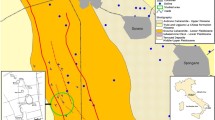Abstract
Three regolith-collapse sinkholes formed near the Dongola Unit School and the Pentecostal Church in the southern Illinois village of Dongola (Union County) during the spring of 1993. The sinkholes appeared over a three-month period that coincided with development of a new municipal well. The new well was drilled through clay-rich, valley-fill sediment into karstified limestone bedrock. The piezometric surface of the limestone aquifer is above land surface, indicating the presence of an upward hydraulic gradient in the valley and that the valley fill is acting as a confining unit. Pumping during development of the well lowered the piezometric surface of the limestone aquifer to an elevation below the base of the valley fill. It is hypothesized that drainage of water from the sediments, the resulting loss of hydrostatic pressure and buoyant force in overlying sediments, increased intergranular pressure, and the initiation of groundwater flow toward the well resulted in rapid sediment transport, subsurface erosion, and collapse of the valley-fill sediment. The sinkholes follow an approximately east-west alignment, which is consistent with one of the two dominant alignments of passages of nearby joint-controlled caves. A constant electrode-separation resistivity survey of the school playground was conducted to locate areas that might contain incipient sinkholes. The survey revealed a positive resistivity anomaly trending N75E in the southern part of the study area. The anomaly is linear, between 5 and 10 m wide, and its trend either intersects or is immediately adjacent to the three sinkholes. The anomaly is interpreted to be a series of pumping-induced cavities in the valley-fill sediments that formed over a preexisting crevice in the karstified bedrock limestone.
Similar content being viewed by others
References
Bretz JH and Harris SE Jr (1961) Caves of Illinois: Illinois State Geological Survey Report of Investigation. 215. Champaign, Illinois. 87 pp
Crawford NC, Webster JW, and Veni G (1989) Sinkhole collapse problems in Warren County, Chapter 4. The karst landscape of Warren County, a technical report for the City-County Planning Commission of Warren County, Kentucky. pp 73–115
Foose RM (1953) Groundwater behavior in the Hershey Valley, Pennsylvania. Geol Soc Am Bull 64:623–645
Freeze RA and Cherry JA (1979) Groundwater. Englewood Cliffs New Jersey: Prentice-Hall. 604 pp
Keys S W (1988) Borehole geophysics applied to groundwater investigations. US Geological Survey Open File Report 87–539. 305 pp
Metcalfe SJ and Hall LE (1984) Sinkhole collapse induced by groundwater pumpage for freeze protection irrigation near Dover Florida January 1977. In: Beck BF (Ed), Sinkholes: Their geology engineering and environmental impact. Rotterdam: A.A. Balkema. pp 28–33
Newton JG (1984) Review of induced sinkhole development. In: Beck BF (Ed), Sinkholes: Their geology engineering and environmental impact. Rotterdam: A.A. Balkema, pp 3–9
Panno SV and Weibel CP (1993) Mapping of karst areas in Illinois: Proceedings of third annual conference—research on agricultural chemicals in Illinois: Status and future directions III, Illinois Groundwater Consortium (in press)
Robinson WH, Ivey JB, and Billingsley GA (1953) Water supply of the Birmingham area, Alabama. US Geological Survey Circular 254. 53 pp
Sinclair A (1974) Selection of threshold values in geochemical data using probability graphs. Geochem Explor 3:129–149
Sinclair WC (1982) Sinkhole development resulting from groundwater withdrawal in the Tampa area, Florida. US Geological Survey Water Resources Investigation 81–50. 19 pp
Van Nostrand RG and Cook KL (1966) Interpretation of resistivity data. US Geological Survey Professional Paper 499. Washington DC: US Government Printing Office. 310 pp
Werner E (1984) Sinkhole protection—review of electrical resistivity methods. In: Beck BF (Ed), Sinkholes: Their geology engineering and environmental impact. Rotterdam: A.A. Balkema. pp 231–234
White WB (1988) Geomorphology and hydrology of karst terrains. New York: Oxford University Press. 464 pp
Willman HB, Atherton E, Buschbach TC, Collinson C, Frye JC, Hopkins ME, Lineback JA, and Simon JA (1975) Handbook of Illinois stratigraphy: Illinois State Geological Survey Bulletin 95 Champaign Illinois 261 pp
Zohdy AAR and Bisdorf RJ (1975) Computer programs for the forward calculation and automatic inversion of Wenner sounding curves. National Technical Information Service US Department of Commerce PB-247 265. 47 pp
Author information
Authors and Affiliations
Rights and permissions
About this article
Cite this article
Panno, S.V., Wiebel, C.P., Heigold, P.C. et al. Formation of regolith-collapse sinkholes in southern Illinois: Interpretation and identification of associated buried cavities. Geo 23, 214–220 (1994). https://doi.org/10.1007/BF00771791
Received:
Accepted:
Issue Date:
DOI: https://doi.org/10.1007/BF00771791




